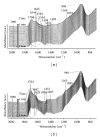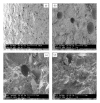Effect of nanoclay dispersion on the properties of a commercial glass ionomer cement
- PMID: 25210518
- PMCID: PMC4158556
- DOI: 10.1155/2014/685389
Effect of nanoclay dispersion on the properties of a commercial glass ionomer cement
Abstract
Objective. The reinforcement effect of polymer-grade montmorillonite (PGV and PGN nanoclay) on Fuji-IX glass ionomer cement was investigated. Materials and Method. PGV and PGV nanoclays (2.0 wt%) were dispersed in the liquid portion of Fuji-IX. Fourier-transform infrared (FTIR) spectroscopy and gel permeation chromatography (GPC) were used to quantify acid-base reaction and the liquid portion of GIC. The mechanical properties (CS, DTS, FS, and E f ) of cements (n = 20) were measured at 1 hour, 1 day, and 1 month. The microstructure was examined by cryo-SEM and TEM. Results. FTIR shows that the setting reaction involves the neutralisation of PAA by the glass powder which was linked with the formation of calcium and aluminium salt-complexes. The experimental GICs (C-V and C-N) exhibited mechanical properties in compliance to ISO standard requirement have higher values than Fuji-IX cement. There was no significant correlation of mechanical properties was found between C-V and C-N. The average Mw of Fuji-IX was 15,700 and the refractive index chromatogram peak area was 33,800. TEM observation confirmed that nanoclays were mostly exfoliated and dispersed in the matrix of GIC. Conclusion. The reinforcement of nanoclays in GICs may potentially produce cements with better mechanical properties without compromising the nature of polyacid neutralisation.
Figures






References
-
- Wilson AD, Kent BE. The glass-ionomer cement: a new translucent dental filling material. Journal of Applied Chemistry Biotechnology. 1971;21:313–318.
-
- Mount GJ. Glass ionomers: a review of their current status. Operative dentistry. 1999;24(2):115–124. - PubMed
-
- Tyas MJ. Clinical evaluation of glass-ionomer cement restorations. Journal of Applied Oral Science. 2006;14:10–13. - PubMed
-
- Randall RC, Wilson NHE. Glass-ionomer restoratives: a systematic review of a secondary caries treatment effect. Journal of Dental Research. 1999;78(2):628–637. - PubMed
-
- Peez R, Frank S. The physical-mechanical performance of the new Ketac Molar Easymix compared to commercially available glass ionomer restoratives. Journal of Dentistry. 2006;34(8):582–587. - PubMed
LinkOut - more resources
Full Text Sources
Other Literature Sources

